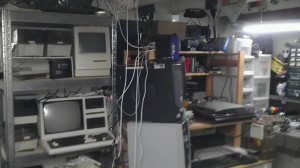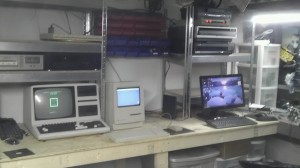Since vintage electronics are a hobby, and not necessarily something I’m able to generally furnish the home with, I needed an adequate space in my house to work with the stuff instead of simply “collecting it”.
Enter the Man Cave. In particular, my Man Cave. A portion of my basement has been set aside for a workshop area. The previous homeowner (or his son) did computer repair in this area of the basement. There was already a homemade workbench installed which I soon turned into a workbench for hobby electronics work. Everything else got stored away in boxes and containers, or placed haphazardly on a variety of shelving systems (as depicted in the Before picture). A collection can easily get out of hand if there isn’t a direct purpose or placement for the items in the collection.
I do like to use what I have from time to time and try to integrate it into my Man Cave and give it a purpose again, if possible. As you can see in the Before picture, I have a variety of items in my collection. I have many other items in storage containers outside of the camera view. What I lacked is an integration of items in my collection which are able to be put to use. I have a collection of vintage audio and video equipment, such as a record player, 8-Track, laserdisc player and a Selectavision player. Until recently, I had those items stored away, making them difficult to enjoy. I also needed an area to do some troubleshooting and repair of the items, if needed. My electronics workbench was too small for some of the items to fit easily. I needed to expand my workbench area.
My first attempt at expanding my workbench, done last summer, is off to the left of the camera view. I built a basic wooden workbench, four feet wide and 30 inches deep, across the room from the original workbench. On top of it, I mounted a set of modular shelves and immediately loaded up those shelves with vintage Commodore computer systems and various accessories. Now I had a place to work with my Commodore Amiga and SX-64.
Before long, the new workbench started to get cluttered. I was running out of space again because I didn’t address my needs as effectively as I could when I built it. However, I liked having my Commodore computers readily accessible. The answer was to build another workbench. But first, I had to overcome my apprehension over what I needed to do first, having to completely tear down the shelving set I have against the wall and effectively rewiring the network of cables I have running through it.
Contained in this photo:
|
There is a lot of “stuff” in the picture. The original workbench can be seen on the right edge of the picture. You can see how crowded that is getting. I have a series of additional parts drawers across the top edge of that workbench, used for repairs and hobby electronics.
It took about four hours to completely tear down that wall of stuff to make way for my newest workbench addition. I basically planned on bridging the two opposing workbenches together with a seven foot wide, 30″ deep, wooden workbench. The workbench was easy enough to build, although I wasn’t able to keep all three workbenches level with each other (poor planning on the previous workbench addition). What I gained with my effort is better use of the available space as you can see in the After picture.
Contained in this photo:
|
As you can see, I have more space to work with. There is room on the shelf for other electronic equipment. I simply have to decide on what I want to put there. The computer flatscreen on the right collapses on the computer base and can slide under the shelf behind it if additional bench space is needed temporarily. The two big PC’s in the before picture have new homes. One is stored below the workbench and the other on the shelving of the workbench I built last year. The metal shelving on the new workbench is the same floor to ceiling shelving shown in the Before picture. It is modular and can be rebuilt as two shorter shelving systems. I left space in the middle of this workbench for two reasons. It gives me a place to mount the parts bins and also gives me an area to pull items out from my collection and place them in an area where I can work with them for a while. Currently the Macintosh Classic is in that space. If I want to work on something else, I can store the Macintosh away and set up something different. I might dig out my TI-99/4A next. I have several Peripheral Expansion Boxes for it which I bought over 15 years ago at a yard sale, but didn’t have the time or place to set them up (EVER) and try them out, until now.







Hey,
Great bit of work you’ve done here. Do you have an email I can grab you on? Tried to locate it and would love to ask you a few questions.
Thanks
Ryan
Thanks for reading my blog! I can be reached at jeff@vintagevolts.com